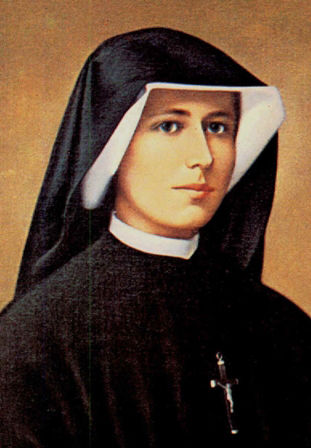April 27 is Divine Mercy Sunday, a fitting occasion for the canonization of Popes John XXIII and, especially, John Paul II who instituted Divine Mercy Sunday (the second Sunday of the Easter season) in 2000.
That was 20 years after John Paul wrote the encyclical “Dives in Misericordia” (“Rich in Mercy”). “The message of Divine Mercy has always been near and dear to me,” explained the pope who described that virtue as the answer to the world’s problems.
His establishment of Divine Mercy Sunday coincided with his canonization of Sister Maria Faustina Kowalska, known as the “Apostle of Mercy” based on her visions and conversations with Jesus, all recorded in her diary and recognized by her spiritual directors.
Pope John Paul called his fellow Pole — who reported 14 revelations concerning the message of Divine Mercy — “the great apostle of Divine Mercy in our time.” He called the day he established Mercy Sunday and canonized Sister Faustina “the happiest day of my life.”
St. Faustina
Helena Kowalska was the third of ten children, born Aug. 25, 1905 in the village of Glogowiec, Poland. At age 20 she entered the Congregation of Sisters of Our Lady of Mercy whose members devote themselves to the care and education of troubled young women.
In the 1930s she received the Lord’s message of mercy and was asked to become the apostle for God’s plan of mercy. She received the prayer of the Chaplet of Divine Mercy through her visions and also was responsible for instructing an artist to portray the image of Christ with rays of love and mercy streaming from his heart. She died in 1938 at age 33.
In 2002, Pope John Paul entrusted the whole world to Divine Mercy when he consecrated the international Shrine of the Divine Mercy in Lagiewnikl, Poland, where St. Faustina’s mortal remains are entombed. The pope frequently quoted from the diary of the saint and prayed the Chaplet of the Divine Mercy at her tomb.
It was during the vigil of the feast of Divine Mercy, on April 2, 2005, that Pope John Paul died.
Dives in Misericordia
In this encyclical, Pope John Paul used the theme of divine mercy that “the modern world needs so much.” He included a long commentary on the Parable of the Prodigal Son that illustrates how mercy “promotes and draws good from all the forms of evil existing in the world and in man.”
The encyclical is divided into eight chapters that highlight the Messianic message, the Paschal Mystery and, finally the prayer of the church.
“At no time and in no historical period-especially at a moment as critical as our own-can the Church forget the prayer that is a cry for the mercy of God amid the many forms of evil which weigh upon humanity and threaten it. Precisely this is the fundamental right and duty of the Church in Christ Jesus, her right and duty towards God and towards humanity” (n. 15)
The Church, said John Paul, has the right and duty to appeal to the God of mercy “in an ardent prayer; in a cry that implores mercy according to the needs of man in the modern world.”
Chaplet of Divine Mercy
The chaplet is a devotion based on the visions of Jesus reported by St. Mary Faustina and is said as a rosary-based prayer beginning with the Our Father, Hail Mary and the Apostle’s Creed. The repeated prayer of each decade is: “For the sake of His sorrowful Passion, have mercy on us and on the whole world.”
According to the saint’s diary, Christ said: “Encourage souls to say the Chaplet which I have given you… whoever will recite it will receive great mercy at the hour of death.”
The chaplet can also be prayed as a novena with a specific intention for each day that ends with the prayer, “Eternal Father, turn your merciful gaze upon lukewarm souls who are nonetheless enfolded in the most compassionate heart of Jesus.”
To view the complete text of “Dives in Misericordia,” visit http://www.vatican.va/holy_father/john_paul_ii/encyclicals/documents/hf_jp-ii_enc_30111980_dives-in-misericordia_en.html.

